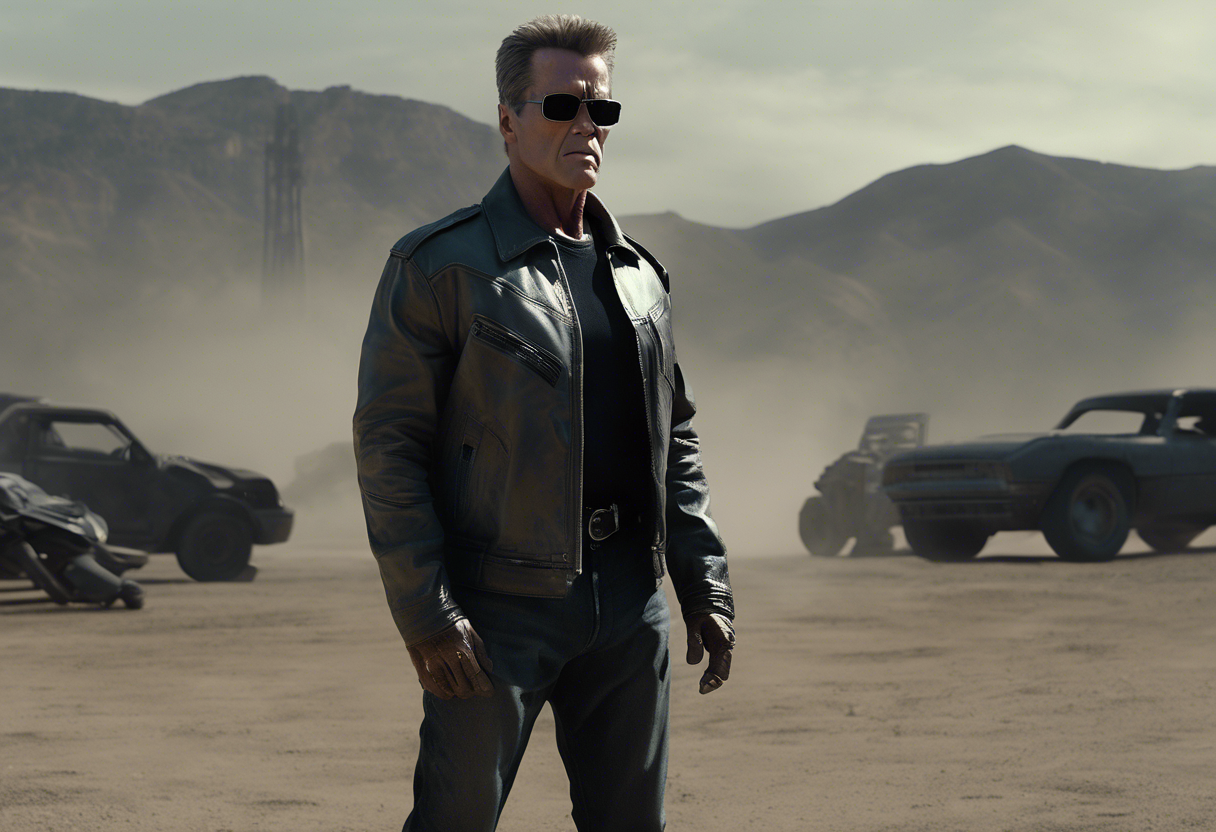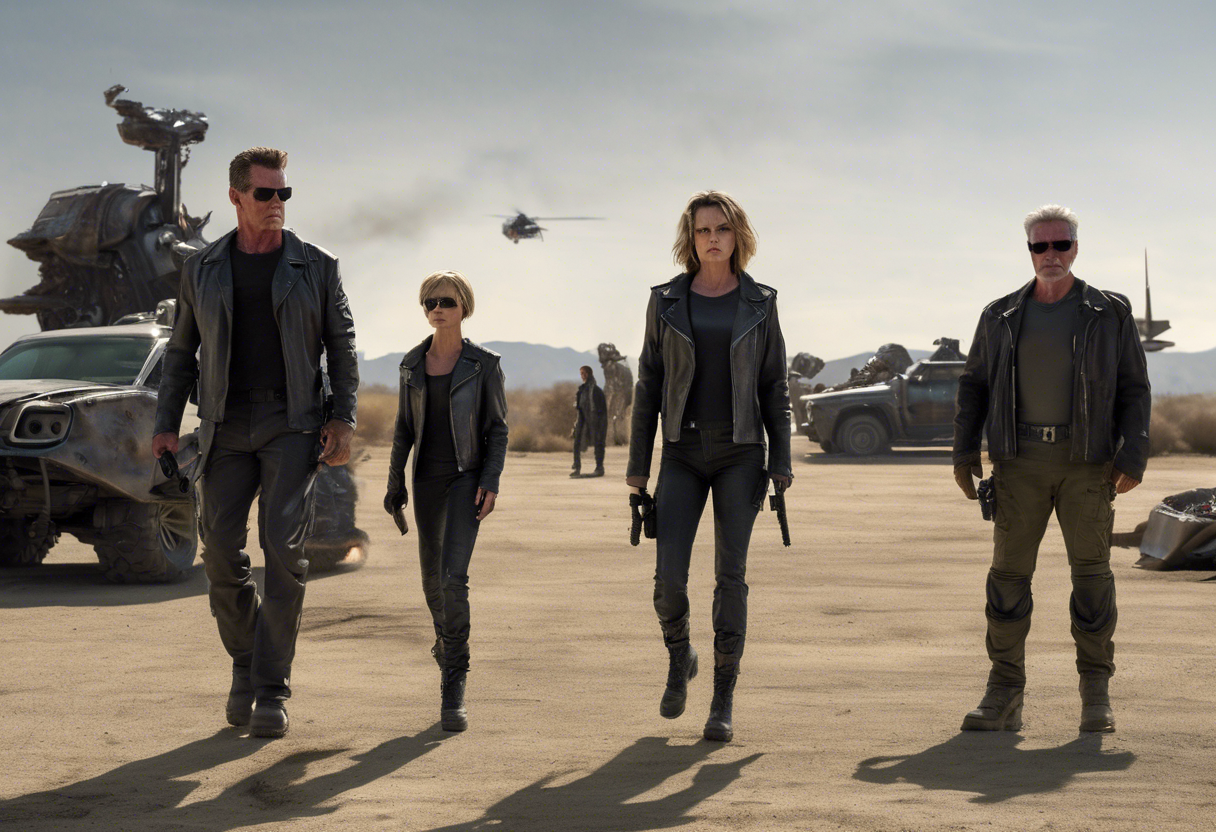Contents
Terminator: Dark Fate
Introduction
Background and Production History
Terminator: Dark Fate, released in 2019, is the sixth installment in the Terminator franchise and serves as a direct sequel to Terminator 2: Judgment Day, ignoring the events of the previous three films. Directed by Tim Miller, the film was written by David S. Goyer, Justin Rhodes, and Billy Ray, with James Cameron and David Ellison among its producers. This approach allowed the filmmakers to reboot the series while maintaining continuity with the highly acclaimed earlier films.
The production of Terminator: Dark Fate involved a significant return to the franchise’s roots, with Linda Hamilton reprising her role as Sarah Connor and Arnold Schwarzenegger once again portraying a Terminator. The film also introduced new characters, including Dani Ramos (Natalia Reyes) and Grace (Mackenzie Davis), an augmented human soldier from the future.
Key Creative Figures
- Director: Tim Miller, known for his work on Deadpool, brought his expertise in action and visual effects to the film.
- Writers: David S. Goyer, Justin Rhodes, and Billy Ray collaborated to create a script that both honored the original films and introduced new elements to the franchise.
- Producers: James Cameron, who created the Terminator franchise, and David Ellison were instrumental in producing the film, ensuring it stayed true to the spirit of the originals.
Initial Release
Terminator: Dark Fate was released on November 1, 2019, in the United States. The film was anticipated for its potential to revitalize the franchise and provide a satisfying continuation of the story that began with Terminator 2: Judgment Day.
What Sets It Apart
Terminator: Dark Fate stands out for its bold decision to disregard the narrative of the previous three films, creating a new timeline that directly follows the events of Terminator 2: Judgment Day. This move allowed the filmmakers to explore fresh themes and characters while maintaining the core elements that made the franchise successful.
Plot Summary
Setting and Initial Events
The film begins in 1998, three years after the events of Terminator 2: Judgment Day. Sarah Connor (Linda Hamilton) and her son John Connor are ambushed by a T-800 Terminator sent back in time by Skynet, resulting in John’s death despite Sarah’s efforts to protect him[1][3].
The story then jumps to 2020, where an advanced Terminator, the Rev-9, is sent back in time to Mexico City to kill Dani Ramos (Natalia Reyes), a young woman who will become a crucial figure in the future resistance against machines. Dani is protected by Grace (Mackenzie Davis), an augmented human soldier from the year 2042[1][3].
Key Characters and Conflicts
- Dani Ramos: A young Mexican woman working at an automobile assembly plant, whose destiny is linked to leading the human resistance against the AI Legion in the future.
- Grace: An augmented human soldier sent back in time to protect Dani from the Rev-9.
- Sarah Connor: The battle-hardened mother of John Connor, who has spent years hunting and killing Terminators after her son’s death.
- Rev-9: An advanced liquid-metal Terminator with the ability to split into its cybernetic endoskeleton and shape-shifting liquid metal exterior.
- Carl (T-800): The Terminator that killed John Connor, who has since gained autonomy and integrated into human society, eventually joining forces with Sarah and Grace to protect Dani[1][3].
Major Conflicts and Climax
The Rev-9 relentlessly pursues Dani, Grace, and Sarah, leading to a series of intense battles and chases. The group seeks the help of Carl, the T-800 Terminator, who has developed a conscience and is living in Laredo, Texas. Together, they plan to destroy the Rev-9 using a military-grade electromagnetic pulse (EMP) generator, but their plans are foiled, and they are forced to improvise[1][3].
The final confrontation takes place at a hydroelectric plant, where Carl and Grace manage to critically damage the Rev-9. However, both Terminators are severely damaged, and Carl sacrifices himself to ensure the Rev-9’s destruction. Dani, with the help of Grace’s power source, ultimately kills the Rev-9[1][3].
Themes and Symbolism
The Continuation of Human Resistance
Terminator: Dark Fate continues the theme of human resistance against machines, but with a new twist. The film introduces Legion, a new AI threat that has replaced Skynet, highlighting the ongoing struggle between humans and machines. Dani Ramos’s character symbolizes the next generation of leaders in this resistance, emphasizing the importance of continuity and the passing of the torch from one generation to the next[1][3].
Redemption and Atonement
The character of Carl, the T-800 Terminator, adds a layer of complexity to the narrative by exploring themes of redemption and atonement. Carl’s actions, which led to John Connor’s death, are mitigated by his later efforts to help Sarah and protect Dani, showing that even machines can seek forgiveness and make amends[1][3].
Female Empowerment
The film features a strong female cast, with Sarah Connor, Grace, and Dani Ramos at the forefront. These characters embody strength, resilience, and leadership, challenging traditional gender roles and stereotypes. The narrative emphasizes their independence and capability, though it also faces criticism for eventually resorting to male rescue tropes[5].
Cultural Impact
Reception Upon Release
Terminator: Dark Fate received mixed reviews upon its release. Critics praised the film’s action sequences, visual effects, and the performances of its female leads. However, some critics felt that the film did not live up to the standards set by its predecessors and that the storyline was overly reliant on familiar tropes[2][5].
Influence on Popular Culture
Despite its mixed reception, Terminator: Dark Fate has contributed to the ongoing discourse about AI, technology, and human survival in popular culture. The film’s depiction of advanced Terminators and the consequences of AI development continues to influence sci-fi narratives and discussions about the ethics of technological advancement.
Adaptations and References
The film’s characters and plot elements have been referenced in various forms of media, including video games and other sci-fi films. The concept of Legion as a successor to Skynet has also been explored in other Terminator media, such as video games and comics[1][3].
Critical Reception
Initial Criticism
Critics at the time of release praised the film’s visuals and action sequences but were divided on its storytelling and character development. Some felt that the film’s reliance on nostalgia and familiar plot points detracted from its originality and impact[2][5].
Controversies and Differing Interpretations
One of the controversies surrounding the film was its handling of the male rescue trope, where despite the strong female characters, the narrative ultimately resorts to Arnold Schwarzenegger’s character saving the day. This was seen as a step back from the film’s otherwise progressive portrayal of women[5].
Long-term Reception
In subsequent years, Terminator: Dark Fate has been reevaluated by some critics and fans who appreciate its efforts to reboot the franchise and introduce new characters. However, it remains a divisive entry in the Terminator series, with opinions split on its success in revitalizing the franchise[2][5].
Legacy
Enduring Relevance
Terminator: Dark Fate continues to be relevant in the context of sci-fi and action films. Its exploration of AI ethics, human resistance, and the consequences of technological advancement remains timely and thought-provoking. The film’s visual effects and action sequences have also influenced the genre, setting a high standard for future films.
Inspiration to Filmmakers and Artists
The film’s bold approach to rebooting a franchise and its emphasis on strong female characters have inspired other filmmakers. The Terminator franchise as a whole, including Dark Fate, continues to be a benchmark for sci-fi action films, influencing both the genre and popular culture.
Place in Cinematic History
Terminator: Dark Fate marks an important chapter in the Terminator franchise, attempting to revitalize the series while honoring its roots. It stands as a testament to the enduring appeal of the Terminator narrative and its ability to evolve and adapt to new themes and characters.
References
- https://en.wikipedia.org/wiki/Terminator:_Dark_Fate
- https://alkony.enerla.net/english/the-nexus/arts/film/terminator-dark-fate-movie-2019-film-review-kadmon
- https://www.imdb.com/title/tt6450804/plotsummary/
- https://en.wikipedia.org/wiki/Terminator_(character_concept)
- https://www.rogerebert.com/reviews/terminator-dark-fate-movie-review-2019



